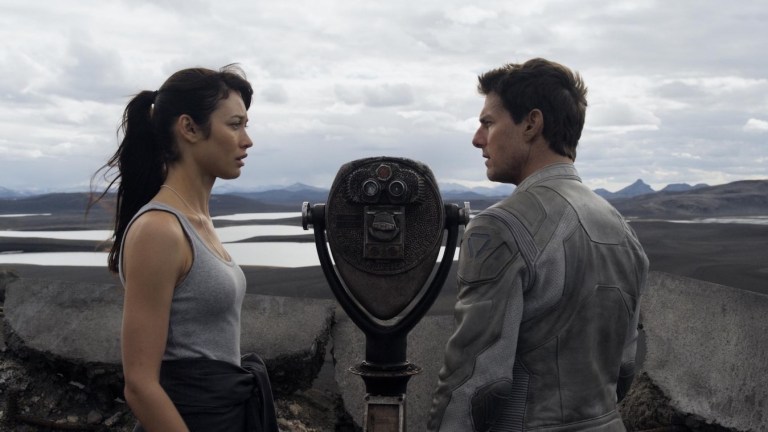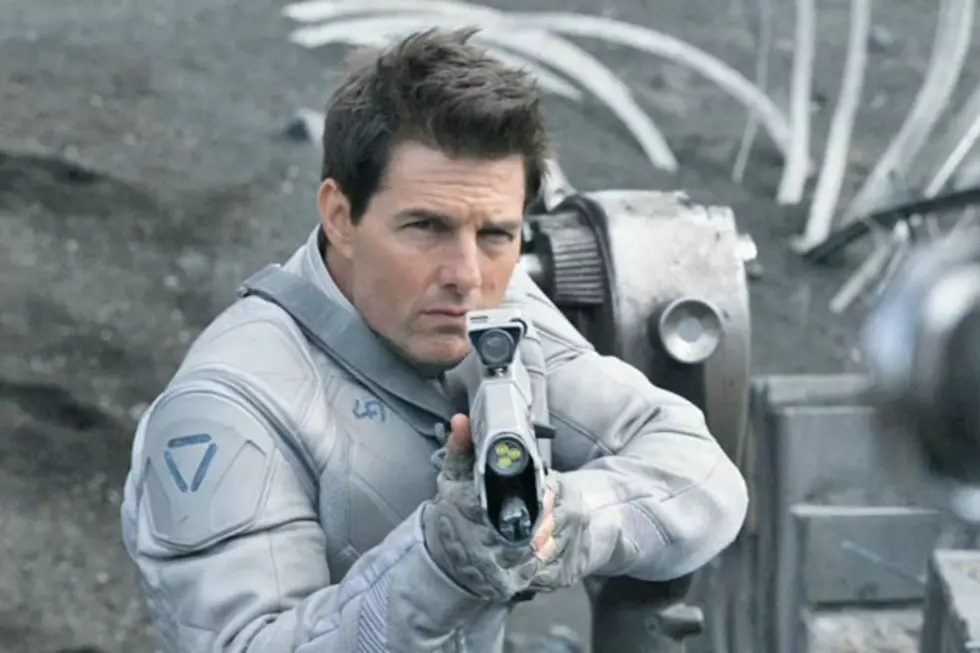Tom Cruise’s Oblivion is an overlooked and minor hit in the star’s filmography. It’s also a tribute to the type of old school sci-fi movies we need to see more of…

Photo: Universal Pictures
Oblivion was released as a Tom Cruise vehicle in 2013, giving him his second best box office weekend up to that time outside of the Mission: Impossible franchise. However, the sci-fi pseudo-epic also received middling reviews and almost immediately dropped out of the public consciousness altogether. Which makes its reemergence into it via Netflix this month intriguing.
Oblivion admittedly has its flaws, yet it is worth a second look if only because it so clearly has ambitions to be something so much more. In 2013 we had only recently gotten a glimpse at what the future held as the commercial effects of the first Avengers movie began to be felt. It was a year of two Marvel movies (three if you count The Wolverine), one Superman movie, and a slew of remakes, reboots, sequels and prequels, from The Hobbit, and The Hunger Games, to Star Trek: Into Darkness and G.I. Joe. But it was also a year that saw a real outburst of non-IP, stand-alone science fiction movies. Gravity, The Europa Report, Elysium, and Snowpiercer all came out this year. These are films that often had flaws, but which were also chock full of ideas and ambition.

So Oblivion entered that market as a film that was already a dying breed: a big budget action movie that was selling itself primarily on a big name star, and Tom Cruise was already one of the few actors who could pull that off. But in doing that, Oblivion also called back to a very specific sci-fi subgenre and a very specific time—the kind we honestly wish they would make more of.
The Omega Movie Star
In Oblivion, megastar Tom Cruise plays one of the last people on a ruined Earth after the rest of the population has been evacuated to Titan. He spends his days looking after his gear and patrolling the apocalyptic hellscape he calls home while fighting off an inhuman threat in the form of the remnants of an alien invasion. Sometimes he will indulge in the music and culture left over from the dead civilization whose ruins he lives among. Eventually, while investigating the inhuman threat, he discovers that actually, it is not they, but he who is the monster. Ultimately, he will be asked to sacrifice himself. Generally speaking, it’s a concept we’ve heard before.
/arc-anglerfish-arc2-prod-pmn.s3.amazonaws.com/public/TG7VZ24SAZBIBGICJIEDRQK6UE.jpg)
In The Omega Man, mega-star Charlton Heston plays the last person on a ruined Earth after the rest of the population is killed or mutated in biological warfare. He spends his days looking at his gear, patrolling the apocalyptic hellscape he calls home while fighting off an inhuman threat in the form of the mutants created by the biological weapons. Sometimes he will indulge in the music and culture left over from the dead civilization whose ruins he lives among. Eventually, while investigating the inhuman threat, he discovers that actually, it is not they, but he who is the monster. Ultimately, he sacrifices himself.
The parallels are not exact, and nobody is suggesting that Oblivion is or was intended to be a direct remake of the Heston film, which is itself a remake of The Last Man on Earth, an adaptation of the novel I Am Legend, which ultimately inspired the entire zombie apocalypse genre.
But The Omega Man is a perfect example of the sub-genre and movie period that Oblivion seeks to emulate.
The Action Science Hero
Around the same time that Charlton Heston made The Omega Man (1971) he also starred in The Planet of the Apes (1968), and Soylent Green (1973). They are spiritually connected films with very clear, common themes. All three are adaptations of science fiction novels, although none of them attempts to trade off the reputation of those novels, changing the titles and plot details at whim to fit the needs of their stories. All three movies are also strong ideas-based films with big, high-concept premises—the world is overrun by mutants, an alien planet where apes are masters over men, and a future where population growth has run out of control. And all three films also pivot on huge (if now no longer surprising) twist: Soylent Green is people, the Planet of the Apes was Earth all along, and the mutants in The Omega Man view Robert Neville (Heston’s character) as the monster.
But also, all three star a kind of Hemingway-esque renaissance man. Across each movie, Heston’s hero is a man of action yet simultaneously a man of science; someone who can throw a punch but who has no problem keeping up with the ideas of pencil-necked professor types.
A Noble Failure
If Oblivion has been produced in the early ‘70s, it’s not hard to see how it might have appealed to Heston. The plot deals with big ideas around civilization, memory, and identity, starring a technically minded action hero with a nose for the classics, and pivoting on a massive perspective-changing twist. It slots right in.
Oblivion knows it too. Throughout the film, it seems to be pointing back to this era of sci-fi to say “See? This is what we’re doing!”
As Cruise’s aircraft flies over the ruined Earth, we see endless recognizable half-submerged landmarks that call out to the lopsided Lady Liberty of Planet of the Apes. His sanctuary, full of old books and vinyl records, is definitely reminiscent of Neville’s fortified home in The Omega Man. Then it hits you with twists, one after the other. The aliens aren’t aliens; they’re human survivors; Cruise isn’t a human, he’s a clone and his wife was his jealous co-pilot; and the space station isn’t a space station, but an alien spaceship (an alien spaceship extremely reminiscent of the HAL 9000 computer in 2001: A Space Odyssey, released in 1968, right around the time of Heston’s sci-fi trilogy).
Oblivion is a film with really strong aesthetics, from the sterile white technology of Cruise’s character’s sky base, aircraft, and drones to the bleakly gray post-apocalyptic landscape, to the retro-coziness of his hideaway. Each of these elements harken back to different parts of this retro-sci-fi subgenre.
And yet, the film falls short of its lofty ambitions. It has big ideas but paper-thin characters—noble action hero, jealous controlling wife (with strong Total Recall vibes, while we’re here), dream woman love interest, and Morgan Freeman playing That Morgan Freeman Character. In his final confrontation with “Tet,” the evil alien spaceship AI that has been secretly controlling him all this time, Cruise delivers the following line: “And how can man die better than facing fearful odds for the ashes of his fathers and the temples of his Gods?”
It is a badass sounding line, from the Lays of Ancient Rome, a collection of narrative poems by Thomas Babington Macaulay. It encapsulates the science action hero archetype Cruise’s character represents. He’s badass, but also familiar with classical literature. It also shows how his longing for a better past has given him a connection to common humanity which he ultimately turns on his creators and masters.
And yet, we are never really given any sense of what those words mean to Cruise’s character. It’s just something cool to say when blowing up an alien spaceship. Still, the film is elevated by its implied epilogue. After Cruise’s character is dead, and his dream wife (who has now been rescued) is living in Cruise’s history shack, she sees one of Cruise’s clones wander out of the woods. One would like to think that every few months from then on, she will have to deal with a new husband turning up.








